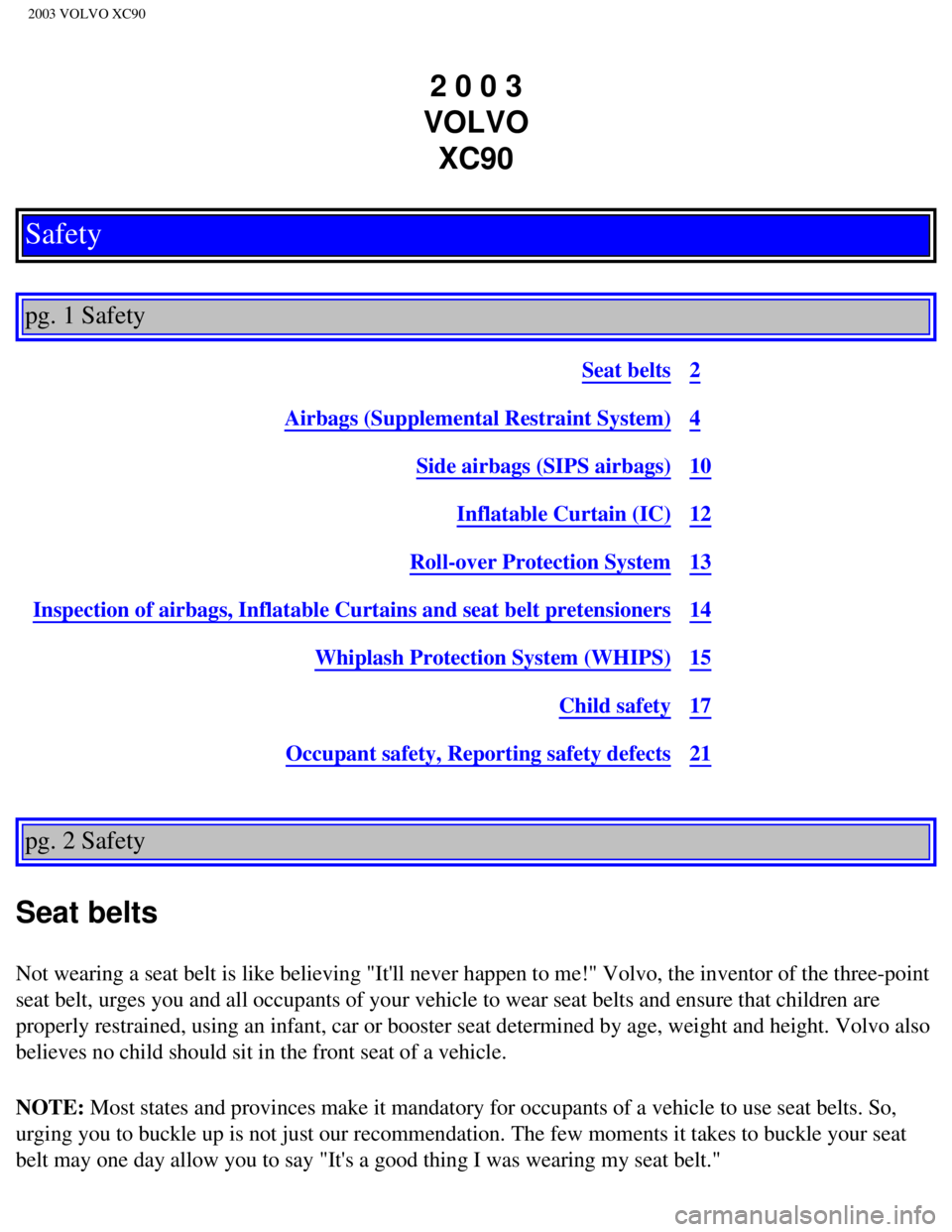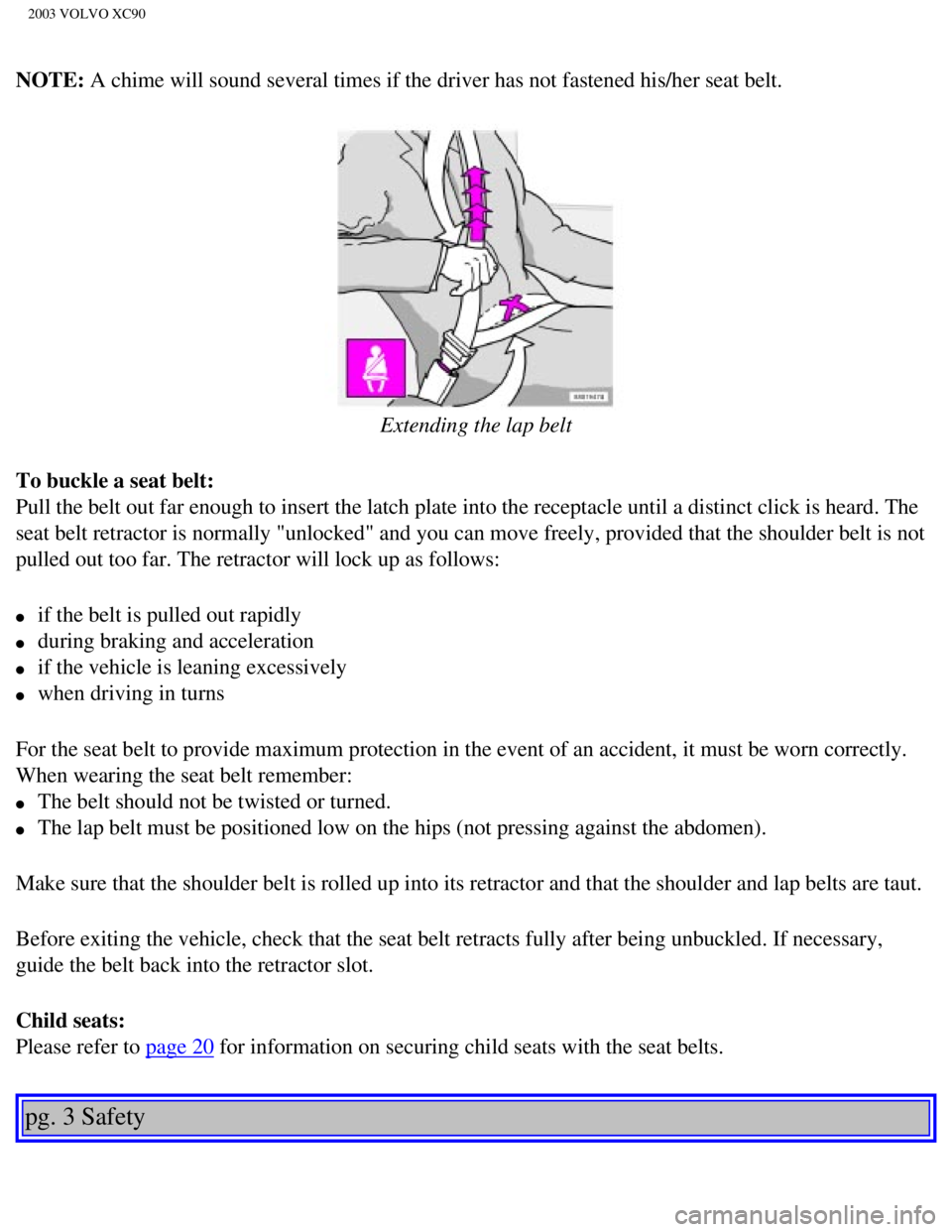2003 VOLVO XC90 child seat
[x] Cancel search: child seatPage 8 of 242

2003 VOLVO XC90
2 0 0 3
VOLVO XC90
Safety
pg. 1 Safety
Seat belts2
Airbags (Supplemental Restraint System)4
Side airbags (SIPS airbags)10
Inflatable Curtain (IC)12
Roll-over Protection System13
Inspection of airbags, Inflatable Curtains and seat belt pretensioners14
Whiplash Protection System (WHIPS)15
Child safety17
Occupant safety, Reporting safety defects21
pg. 2 Safety
Seat belts
Not wearing a seat belt is like believing "It'll never happen to me!" Vo\
lvo, the inventor of the three-point
seat belt, urges you and all occupants of your vehicle to wear seat belt\
s and ensure that children are
properly restrained, using an infant, car or booster seat determined by \
age, weight and height. Volvo also
believes no child should sit in the front seat of a vehicle.
NOTE: Most states and provinces make it mandatory for occupants of a vehicle \
to use seat belts. So,
urging you to buckle up is not just our recommendation. The few moments \
it takes to buckle your seat
belt may one day allow you to say "It's a good thing I was wearing my se\
at belt."
file:///K|/ownersdocs/2003/2003_XC90/03xc90_01a.htm (1 of 12)12/30/200\
6 4:18:49 PM
Page 9 of 242

2003 VOLVO XC90
NOTE: A chime will sound several times if the driver has not fastened his/her\
seat belt.
Extending the lap belt
To buckle a seat belt:
Pull the belt out far enough to insert the latch plate into the receptac\
le until a distinct click is heard. The
seat belt retractor is normally "unlocked" and you can move freely, prov\
ided that the shoulder belt is not
pulled out too far. The retractor will lock up as follows:
l if the belt is pulled out rapidly
l during braking and acceleration
l if the vehicle is leaning excessively
l when driving in turns
For the seat belt to provide maximum protection in the event of an accid\
ent, it must be worn correctly.
When wearing the seat belt remember:
l The belt should not be twisted or turned.
l The lap belt must be positioned low on the hips (not pressing against t\
he abdomen).
Make sure that the shoulder belt is rolled up into its retractor and tha\
t the shoulder and lap belts are taut.
Before exiting the vehicle, check that the seat belt retracts fully afte\
r being unbuckled. If necessary,
guide the belt back into the retractor slot.
Child seats:
Please refer to
page 20 for information on securing child seats with the seat belts.
pg. 3 Safety
file:///K|/ownersdocs/2003/2003_XC90/03xc90_01a.htm (2 of 12)12/30/200\
6 4:18:49 PM
Page 10 of 242

2003 VOLVO XC90
During pregnancy
Pregnant women should always wear seat belts. Remember that the belt sho\
uld always be positioned in
such a way as to avoid any possible pressure on the abdomen. The lap por\
tion of the belt should be
located low, as shown in the above illustration.
WARNING!
Seat belts:
l Never use a seat belt for more than one occupant. Never wear the shoulde\
r portion of the belt under
the arm, behind the back or otherwise out of position. Such use could ca\
use injury in the event of an
accident. As seat belts lose much of their strength when exposed to viol\
ent stretching, they should be
replaced after any collision, even if they appear to be undamaged.
l Never repair the belt on your own; have this work done by an authorized \
Volvo retailer only.
l Any device used to induce slack into the shoulder belt portion of the th\
ree-point belt system will
have a detrimental effect on the amount of protection available to you i\
n the event of a collision.
l The seat back should not be tilted too far back. The shoulder belt must \
be taut in order to function
properly.
l Do not use child safety seats or child booster cushions/backrests in the\
front passenger's seat. We
also recommend that children who have outgrown these devices sit in the \
rear seat with the seat belt
properly fastened.
file:///K|/ownersdocs/2003/2003_XC90/03xc90_01a.htm (3 of 12)12/30/200\
6 4:18:49 PM
Page 14 of 242

2003 VOLVO XC90
NOTE:
Deployment of SRS components occurs only one time during an accident. In\
a collision where
deployment occurs, the airbags and seat belt pretensioners activate. Som\
e noise occurs and a small
amount of powder is released. The release of the powder may appear as sm\
oke-like matter. This is a
normal characteristic and does not indicate fire.
NOTE:
Volvo's dual-threshold, dual-stage airbags use special sensors that are \
integrated with the front seat
buckles. The point at which the airbag deploys is determined by whether \
or not the seat belt is being
used, as well as the severity of the collision. Collisions can occur whe\
re only one of the airbags deploys.
If the impact is less severe, but severe enough to present a clear injur\
y risk, the dual-stage airbags are
triggered at 70% of their total capacity. If the impact is more severe, \
the dual-stage airbags are triggered
at full capacity.
WARNING!
Do not use child safety seats or child booster cushions/backrests in the\
front passenger's seat. We also
recommend that occupants under 4 feet 7 inches (140 cm) in height who \
have outgrown these devices
sit in the rear seat with the seat belt fastened. Never drive with the a\
irbags deployed. The fact that
they hang out can impair the steering of your vehicle. Other safety syst\
ems can also be damaged. The
smoke and dust formed when the airbags are deployed can cause skin and e\
ye irritation in the event of
prolonged exposure.
pg. 6 Safety
Airbags (Supplemental Restraint System) (contd)
file:///K|/ownersdocs/2003/2003_XC90/03xc90_01a.htm (7 of 12)12/30/200\
6 4:18:49 PM
Page 15 of 242

2003 VOLVO XC90
WARNING!
Children must never be allowed in the front passenger's seat. Volvo reco\
mmends that ALL occupants
(adults and children) shorter than 4 feet 7 inches (140 cm) be seate\
d in the back seat of any vehicle
with a front passenger-side airbag. See
page 20 for guidelines.
Occupants in the front passenger's seat must never sit on the edge of th\
e seat, sit leaning toward the
instrument panel or otherwise sit out of position. The occupant's back m\
ust be as upright as comfort
allows and be against the seat back with the seat belt properly fastened\
.
Feet must be on the floor, e.g. not on the dash, seat or out of the wind\
ow. No objects or accessory
equipment, e.g. dashboard covers, may be placed on, attached to, or inst\
alled near the SRS hatch (the
area above the glove compartment) or the area affected by airbag deploy\
ment (see illustration on
page
4).
There should be no loose articles, e.g. coffee cups, on the floor, seat \
or dashboard area. Never try to
open the SRS cover on the steering wheel or the passenger side dash. Thi\
s should only be done by an
authorized Volvo service technician.
Failure to follow these instructions can result in injury to the vehicle\
occupants.
Warning light in the instrument panel
A self-diagnostic system incorporated in the sensor monitors the SRS. Th\
is system does not, however,
monitor the Side Impact Protection System (SIPS) airbags. If a fault i\
s detected, the warning light will
illuminate. The light is included in the warning/indicator light cluster\
in the instrument panel. Normally,
the SRS warning lamp should light up when the ignition key is turned to \
positions I, II or III and should
go out after 7 seconds or when the engine is started. Check that this li\
ght is functioning properly every
time the vehicle is started.
The following items are monitored by the self-diagnostic system:
l Sensor unit
l Cable harness
l Gas generator
file:///K|/ownersdocs/2003/2003_XC90/03xc90_01a.htm (8 of 12)12/30/200\
6 4:18:49 PM
Page 23 of 242

2003 VOLVO XC90
WARNING!
The IC system is a supplement to the Side Impact Protection System. It i\
s not designed to deploy
during collisions from the front or rear of the vehicle. The Inflatable \
Curtains are designed to deploy
only during certain side-impact collisions, depending on the crash sever\
ity, angle, speed and impact.
The Inflatable Curtains are not designed to deploy in all side impact si\
tuations. Never try to open or
repair any components of the IC system. This should be done only by an a\
uthorized Volvo service
technician. In order for the IC to provide its best protection, both fro\
nt seat occupants and all
outboard rear seat occupants should sit in an upright position with the \
seat belt properly fastened;
adults using the seat belt and children using the proper child restraint\
system. Only adults should sit in
the front seats. Children must never be allowed in the front passenger s\
eat. See
page 20 for
guidelines. Failure to follow these instructions can result in injury to\
the vehicle occupants in an
accident.
When the backrest(s) in the rear seat(s) are folded down, the vehicl\
e should not be loaded to a level
higher than 2 inches (5 cm) below the upper edge of the side windows. \
Objects placed higher than
this level could impede the function of the Inflatable Curtain.
pg. 13 Safety
Roll-over Protection System
Volvo's Roll-over Protection System has been developed to help prevent t\
he vehicle from rolling over in
the event of sudden evasive maneuvers, skids, etc and to offer enhanced \
protection if a roll-over occurs.
The system works in two ways:
l The stabilizing system Roll Stability Control (RSC) acts to minimize b\
ody roll.
l The system provides additional protection with a reinforced body, Inflat\
able Curtains for all outboard
seating positions, and seat belt pretensioners for all seating positions\
.
RSC uses a gyro-sensor that registers the vehicle's angle of inclination\
and the speed at which this angle
changes. Using this information, the control module calculates the risk \
of a roll-over. If there is an
imminent roll-over risk, the Dynamic Stability and Traction Control (DS\
TC) system is activated, engine
speed is reduced, and the brakes are applied to one or more of the wheel\
s until the vehicle has regained
stability.
If a roll-over occurs, RSC triggers the seat belt pretensioners and then\
deploys the Inflatable Curtains
(which remain inflated for approximately 5 seconds). These curtains ar\
e designed to follow the contours
of the side windows so that they position themselves between the occupan\
ts' heads and the sides of the
vehicle.
pg. 14 Safety
file:///K|/ownersdocs/2003/2003_XC90/03xc90_01b.htm (4 of 15)12/30/200\
6 4:18:50 PM
Page 26 of 242

2003 VOLVO XC90
WARNING!
If the rear seat backrests are folded down, cargo must be secured to pre\
vent it from sliding forward
against the front seat backrests in the event of a collision from the re\
ar. This could interfere with the
action of the WHIPS system.
The WHIPS system is designed to function in certain collisions from the \
rear, depending on the crash
severity, angle and speed.
Occupants in the front seats must never sit out of position. The occupan\
t's back must be as upright as
comfort allows and be against the seat back with the seat belt properly \
fastened.
pg. 16 Safety
WARNING!
Any contact between the front seat backrests and the folded rear seat co\
uld impede the function of the
WHIPS system. If the rear seat is folded down, the occupied front seats \
must be adjusted forward so
that they do not touch the folded rear seat.
Boxes, suitcases, etc. wedged behind the front seats (see illustration \
above) could impede the function
of the WHIPS system.
pg. 17 Safety
Child safety
Volvo recommends the proper use of restraint systems for all occupants i\
ncluding children. Remember
file:///K|/ownersdocs/2003/2003_XC90/03xc90_01b.htm (7 of 15)12/30/200\
6 4:18:50 PM
Page 27 of 242

2003 VOLVO XC90
that, regardless of age and size, a child should always be properly rest\
rained in a vehicle.
Your vehicle is also equipped with ISOFIX attachments, which make it mor\
e convenient to install child
seats (see
page 18).
Restraint systems for children are designed to be secured in the vehicle\
by lap belts or the lap portion of
a lap-shoulder belt. Such child restraint systems can help protect child\
ren in vehicles in the event of an
accident only if they are used properly. However, children could be enda\
ngered in a crash if the child
restraints are not properly secured in the vehicle. Failure to follow th\
e installation instructions for your
child restraint can result in your child striking the vehicle's interior\
in a sudden stop.
Holding a child in your arms is NOT a suitable substitute for a child re\
straint system. In an accident, a
child held in a person's arms can be crushed between the vehicle's inter\
ior and an unrestrained person.
The child could also be injured by striking the interior, or by being ej\
ected from the vehicle during a
sudden maneuver or impact. The same can also happen if the infant or chi\
ld rides unrestrained on the
seat. Other occupants should also be properly restrained to help reduce \
the chance of injuring or
increasing the injury of a child. All states and provinces have legislat\
ion governing how and where
children should be carried in a vehicle. Find out the regulations existi\
ng in your state or province. Recent
accident statistics have shown that children are safer in rear seating p\
ositions than front seating positions
when properly restrained. A child restraint system can help protect a ch\
ild in a vehicle. Here's what to
look for when selecting a child restraint system:
l It should have a label certifying that it meets applicable Federal Motor\
Vehicle Safety Standards
(FMVSS 213) - or in Canada, CMVSS 213.
l Make sure the child restraint system is approved for the child's height,\
weight and development - the
label required by the standard or regulation, or instructions for infant\
restraints, typically provide this
information.
l In using any child restraint system, we urge you to carefully look over \
the instructions that are
provided with the restraint. Be sure you understand them and can use the\
device properly and safely in
this vehicle. A misused child restraint system can result in increased i\
njuries for both the infant or child
and other occupants in the vehicle.
When a child has outgrown the child safety seat, you should use the rear\
seat with the standard seat belt
fastened. The best way to help protect the child here is to place the ch\
ild on a cushion so that the seat
belt is properly located on the hips (see
page 2). Legislation in your state or province may mandate the
use of a child seat or cushion in combination with the seat belt, depend\
ing on the child's age and/or size.
Please check local regulations.
A specially designed and tested booster cushion (not available in Canad\
a) for children between the age
of 3 and approximately 10 years, weighing 33-80 lb (15-36 kg) and 38-5\
4 inches (97-137 cm) in height,
can be obtained from your Volvo retailer.
file:///K|/ownersdocs/2003/2003_XC90/03xc90_01b.htm (8 of 15)12/30/200\
6 4:18:50 PM